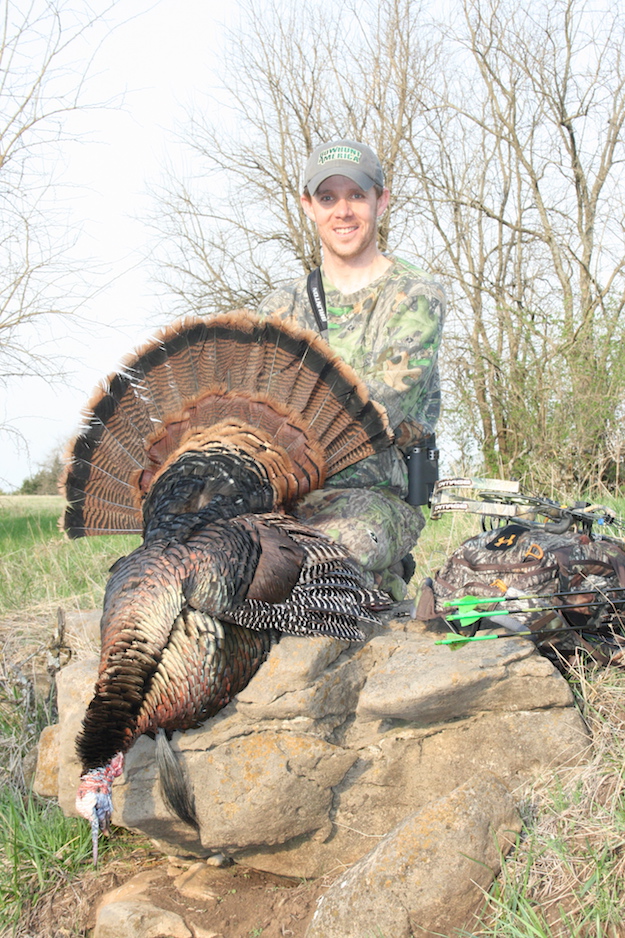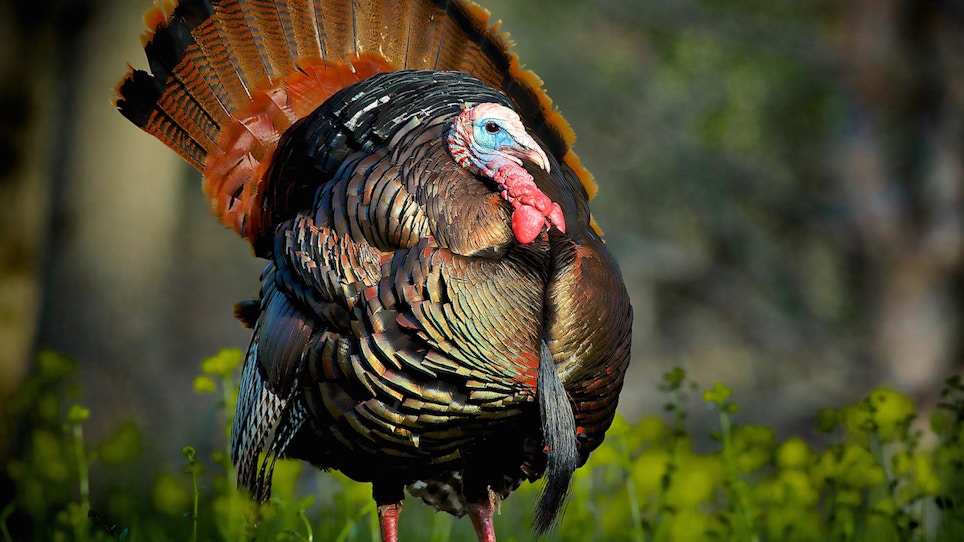Photo: iStock/Jeffengeloutdoors.com
Looking to make your Grand Slam Turkey run this spring, or just to add a new species to the list? I’ve been chasing wild turkeys across the country for over a decade with archery tackle, and during that time I’ve adapted a system for each particular subspecies that has proven effective time and time again. Over the next four weeks I will be reviewing some surefire recipes for success for each of the four turkey subspecies recognized by the National Wild Turkey Federation.
The Eastern 411
The Eastern turkey is by far the most plentiful of the four subspecies of wild turkeys we will be highlighting. With a total estimated population close to 5.4 million, the Eastern subspecies inhabits 38 U.S. states and five Canadian provinces, ranging from New England and southern Canada down to northern Florida, over to eastern Texas and up to Minnesota.
A true success story, the Eastern wild turkey was hunted to near extinction in the 1800s due to nonexistent hunting laws. By 1900, numbers across the eastern United States were strikingly low, and had restoration attempts not been started in 1960, this awe-inspiring bird might have been lost forever.
It is debated whether the Eastern or Merriam’s subspecies is the largest, but a mature Eastern male will typically weigh between 18 and 30 pounds, and a mature female will tip the scales at around 12 pounds.
With a tail fan that is much darker (chestnut-brown tips on the tail feathers) than the Rio or the Merriam’s, the Eastern’s primary color is an iridescent bronze. The wings on both the male and the female have alternating dark and light bands. In my experience, the Eastern turkey tends to have thicker and even longer beards than the Rio or the Merriam’s.
The Eastern prefers hardwood and pine forests that give way to agricultural ground. Roughly 85 percent of an Eastern turkey’s diet is plant-based, with insects making up the other 15 percent. Like most subspecies, the Eastern will hold to a certain territory in the winter months, but it isn’t at all uncommon for the birds to range up to 4 and 5 miles during breeding season.
Super Gobblers
When it comes to the Eastern’s gobble, nothing is more exciting. A mature tom tucked deep in the hardwoods will rattle the forest. According to the NWTF, the Eastern boasts the loudest gobble of all turkey subspecies. It’s this gobble that causes me to chase these creatures whenever possible. When you’re in the woods and a coming-to-your-call tom gobbles, the sound will shake your chest.
Get Away From The Crowd
Because Eastern birds are so plentiful, they are heavily pursued by hunters. This makes harvesting a mature Eastern with archery tackle a real challenge. Public-land areas tend to get hunted hard, making the birds call-shy and reluctant to gobble.
My best recipe for success when bowhunting public-land Eastern birds is to go small. I ignore those larger tracts of land that draw more attention from other hunters. I also often ignore those with agriculture. Lots of bowhunters like to make field-edge sits for turkeys, and more open areas allow prospecting bowhunters to glass and find birds. I focus my efforts on small 60- to 80-acre areas of timber that tend to get overlooked. Of course, I will also venture into large tracts of national forests where I can get away from the crowds.
There are some big national forest areas where Eastern turkeys roam, and when hunting these areas I employ my go-deep Merriam’s turkey techniques mentioned in Part I.
Another public-land Eastern tip I highly recommend is getting into the thick timber, setting up a ground blind in a semi-open area and waiting. I wander around the woods with a blind on my back until I find turkey sign, and then I post up. Typically, I will just listen for an hour or two. Oftentimes I will hear a hen yelp, detect a gobble or simply hear a few birds scratching in the leaves. If possible, I like to let a situation develop before I start calling. Listen more and call less. Once I know turkeys are in the area and are talking a little on their own, I will start with some light yelping and purring. If I get a response, I will, as I’ve mentioned in Part I and Part II, match my calling to the attitude of the birds in the area. If I don’t get a response, I repeat my calling routine every 15 to 20 minutes. I never get loud but simply try to make natural turkey sounds. I will shuffle the leaves around with my feet and beat on my backpack with a turkey wing I like to carry. These are natural sounds the birds hear in the woods every day.
More often than not, if I stay in my blind and stay patient, I will have a tom wander in silently at some point. Often, I will see the bird coming or simply hear spitting and drumming coming from just behind my blind.
Decoying Easterns
Decoys are great, and when hunting Eastern birds I often utilize the same setup mentioned in the previous two articles. However, many times, especially on pressured public land and when hunting in the thick timber, I will simply go without decoys. When in the deep timber, approaching toms know they will have to keep a keen eye peeled. Spotting a sexy lady in the timber is much different that spotting one on a field’s edge. Oftentimes an approaching bird will wander into range while searching for a mate.
If you find a pocket of unpressured birds, field-edge or more open-type setups will work. A mature Eastern tom is about as aggressive as any bird I’ve hunted, and if you can get a couple of decoys in a highly visible area, you may be in for some hot action. Again, these open areas do tend to draw crowds.
Ground Blinds...Or Not
When bowhunting Eastern birds on small pockets of public dirt, I bounce around a lot, and toting a ground blind isn’t always the best choice. Sure, nothing conceals you like a hub-style blind, but I’ve found that if I tuck into the brush and stay still, I can usually get drawn on a bird that has become infatuated with a decoy. I use this method a lot when exploring new tracts of ground. If you have time, you can, of course, construct a small blind from forest debris and vegetation. Just be sure to check state game laws before trimming brush or vegetation, as the practice is illegal in some states on public land.
Due to their hard-gobbling and often aggressive nature, the Eastern is by far my favorite species of turkey to bowhunt. I also credit them as being the most difficult of the four subspecies to harvest with a stick and string on public dirt. These birds seem to have a knack for detecting human presence, and they just don’t make many mistakes.
Regardless of where you decide to hunt an Eastern gobbler, stay focused and patient. You’re going to need to spend lots of time in the woods and do a lot of property hopping to wind up with a punched tag.






